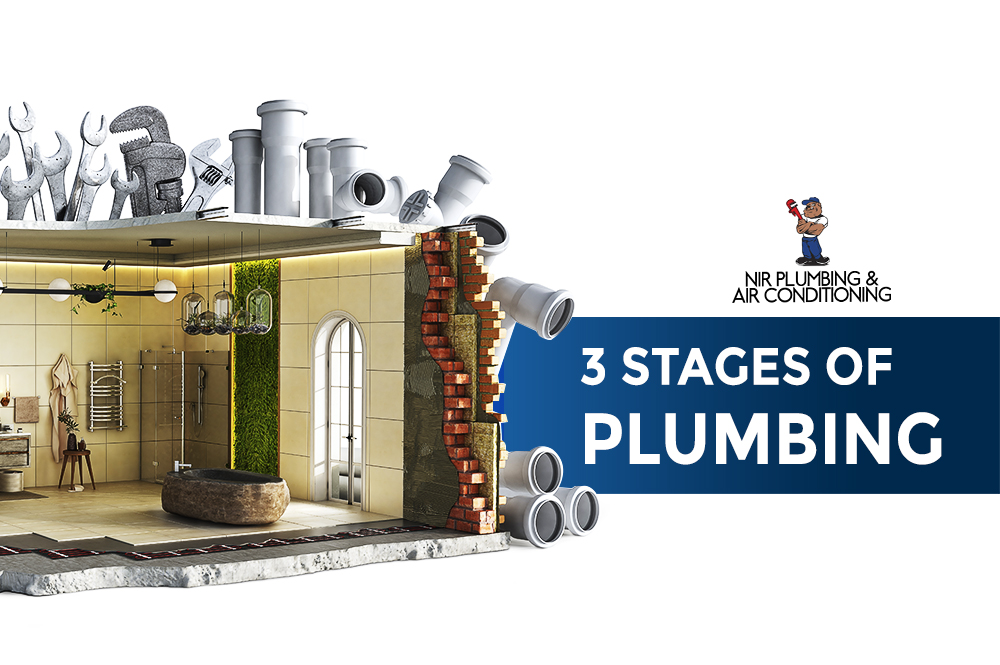[vc_row][vc_column width=”1/1″][vc_column_text]Installing new plumbing in a house? Here are the 3 stages to successful pipe installation
If you’re building a new home or any type of establishment, you know that you’ll need to install plumbing. As with so many areas of construction and renovation, there are certain stages that are required to be completed prior to moving on.
This article is about the different stages of plumbing that happen in new home construction, renovation, or basement development. A home plumbing installation isn’t completed all at once but in 3 stages, to be exact:
-
Underground rough-in phase
-
Aboveground rough-in phase (top-out or stack-out)
-
Finishing phase (Trim-out or trim finish)
What can be regarded as the fourth phase of plumbing projects? Service and maintenance.[/vc_column_text][vc_column_text]
What Is The Underground Rough-in Phase?
[/vc_column_text][vc_column_text]
In new home construction there are two points when the groundwork can be done:
-
Once the walls are poured for the basement, the groundwork can be installed, inspected, and then buried.
-
At the same time as the rest of the rough-in plumbing. (You would need to check with the city to make sure this is doable.)
During the underground rough-in phase, a plumber locates all the supply and waste connections from the building system to public utilities, and establishes where these systems will enter or leave the building.
This means all of the drains will be hooked up to the main service and any basement bathrooms for the future will need to be installed at this point. Also, the main water line will need to be brought from the service to the area where the meter will eventually be placed.[/vc_column_text][vc_column_text]
What Is The Aboveground Rough-in Phase?
[/vc_column_text][vc_column_text]
As we briefly mentioned above, the rough-in plumbing stage can be part of the groundwork stage. But this isn’t always the case. At this stage, you’ll need to install all of your drains and vent pipes as well as the water lines.
You will also need to install all of the bathtubs, showers, or shower bases that you have going into your house. This has to be done regardless of whether you are building a new home, basement development or renovating your house.
During the aboveground rough-in phase, a plumber:
-
Cuts holes in wall, ceiling, or floor to attach or hang pipes for connection to fixtures
-
Installs the pipe for the building’s various supply and waste system
-
Uses welding tools, soldering equipment to join pipe runs, or special chemicals for plastic pipes
-
Operates power threading machines, propane torches, and other power tools
Before the drywall can be put up you will need all of your gas lines installed as well. This is always part of the rough in plumbing stage, but sometimes left to another contractor if the plumber does not have a gas ticket.
Make sure the plumber you hire tests everything before the walls are closed up.[/vc_column_text][vc_column_text]
What Is The Finishing Phase?
[/vc_column_text][vc_column_text]
In the finish phase, the plumber installs fixtures such as sinks, showers, and toilet appliances such as dishwashers, water purification system, and water heater. As well as installing the water heater, hooking up the fireplaces and other gas appliances.
After each fixture has been installed your plumber (Kramer Plumbing and Radiant Heat will) should check for leaks on all fixtures and appliances.
The plumber may be called on to install the automatic controls that regulate the pressurized pipe system as well.
Related article: Stages of Plumbing
Just a side note. If you are installing a claw foot tub or freestanding tub then you will do this in the finish stage not the rough-in stage. The same will be true in some cases for showers that get slid into place.
[/vc_column_text][vc_column_text]
Service And Maintenance
[/vc_column_text][vc_column_text]
Regardless of how well a plumbing system is installed, it must be maintained and periodically repaired. Service and maintenance can even be regarded as the fourth phase of plumbing projects.
Plumbers perform a variety of tasks as part of service and maintenance. These tasks include the following:
-
Checking lubrication levels and pumps, test gauges and meters
-
Repairing faulty fixtures and components
-
Verifying the operating system
-
Regulating the flow and usage rate
[/vc_column_text][vc_column_text]
IN CONCLUSION
[/vc_column_text][vc_column_text]
Tuckers gives a basic but comprehensive summary of the steps for a new plumbing installation can be found below:
-
The plumber performs measurements for all of the planned pipelines: charting a path through the walls, floor and ceiling as well as factoring in removal of drywall, floor tiles and the like.
-
The plumber ascertains where the new plumbing will connect to any existing plumbing, and whether the new system will require any valves, seals or the like.
-
The plumber measures the square footage required for new, sinks, toilets or similar appliances, making sure that not only that the space is properly fitted, but that the counter top and/or floor can support the weight.
-
The plumber shuts off the water main to the section to be expanded (and if necessary, the entire house.)
-
The plumber lays down plastic sheeting to protect as much of the surrounding area as possible.
-
The plumber opens up the path to be used by the new piping: cutting away drywall, lifting tiles and the like.
-
The plumber installs the new piping, taking care that all of the seals and connections are firm.
-
The plumber installs any appliances involved in the expansion, including toilets and sinks.
-
The plumber connects the appliances to the piping.
-
The plumber seals the appliances in place with grouting, then turns the water back on and tests to see if everything is functioning.
-
The plumber restores the tiles, seals up the drywall and otherwise returns the space to its former condition.
While new plumbing can be a big undertaking, you can create the kitchen or bathroom of your dreams with the right contractor and a lot of planning.
If you need a plumber for your next new home build, renovation, service call, or basement development, we would be happy to help. We have four locations to better serve our clients in the Inland Empire!
Find us in Riverside, Moreno Valley, Corona, and Redlands. 951 300 6681[/vc_column_text][/vc_column][/vc_row]


